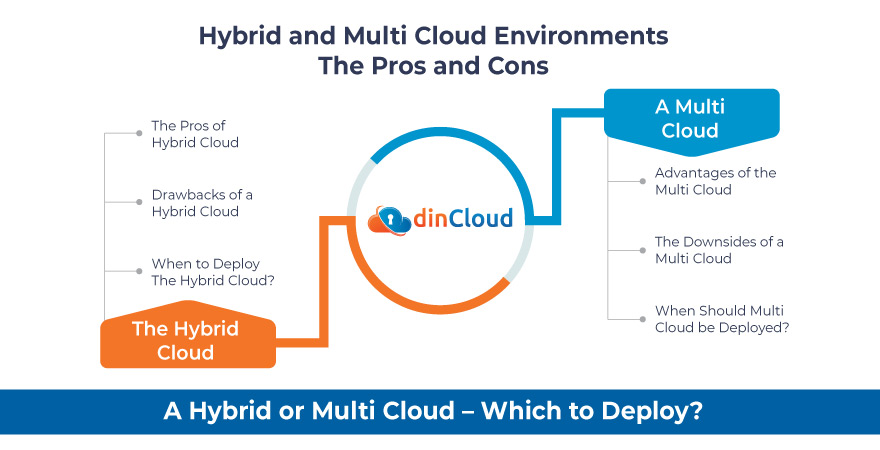Hybrid Cloud Challenges
If setup the right way, a Hybrid Cloud stands to deliver the deploying enterprises the “best of both worlds”. These are some of the major Hybrid Cloud Challenges:-
- Mapping the on-premise and cloud workloads is complex.
- IT admins have to give away some visibility for efficiency.
- In-house IT and Cloud Computing experts are necessary.
- Unified network logging and monitoring can’t be achieved.
- Deploying a centralized security mechanism is not possible.
In this post, we will cover the key elements of hybrid and multi cloud environments. We will also discuss the pros and cons of both. Towards the end, we will try to conclude about the optimal cloud deployment model for your enterprise.

The Hybrid Cloud
As the name suggests, a hybrid cloud deployment is a combination of both on-premise IT infrastructure resources, and a public cloud provider like dinCloud. Enterprises opt for a hybrid cloud model for a host of reasons, flexibility and costs being the major two.
A Multi Cloud
A multi cloud environment is comprised of more than one public cloud providers. Enterprises generally opt for a multi cloud environment, when they want to tap into the unique benefits or core competencies of more than any one particular cloud provider.
The Pros of Hybrid Cloud
In a hybrid cloud environment, enterprises enjoy a much higher degree of control on which workloads to retain in-house, and which of the workloads can be delegated to a public cloud provider like dinCloud. This model is also generally good for regulatory matters.
Also Read: Hybrid Cloud Environments and the Benefits of Clusters
Drawbacks of a Hybrid Cloud
While an enterprise can delegate some of its workloads to the public cloud provider like dinCloud, it still has to contend with the costs and management overheads of having a large footprint of IT hardware in house. This also inflates the costs in most cases.
Advantages of the Multi Cloud
In theory, a well planned and executed multi cloud stands to deliver the “best of all worlds”. An enterprise can avail the Software as a Service (SaaS) solution of one cloud provider, while the infrastructure of another public cloud provider like dinCloud.
Also Read: Common Cloud Use Cases for Hybrid SQL Server
The Downsides of a Multi Cloud
In reality however, multi cloud environments are very complex, both from a management as well as security standpoint. Each cloud provider has its own unique set of protocols and way of doing things. As a result, there are many integration related challenges at times.
Also Read: Why Hybrid and Multi Cloud Deployments are Inevitable?
A Hybrid or Multi Cloud – Which to Deploy?
So, what we are left with is the all important issue of which cloud deployment model to implement at the enterprise level. Well, there is no definitive or universal answer to this important question. The deployment model will depend on each individual entity.
When to Deploy The Hybrid Cloud?
A hybrid cloud will be suitable when either the nature of operations of an enterprise, or regulatory standards, necessitate absolute governance over data. In that case, an enterprise should go for a hybrid cloud and retain critical workloads on premise.
Also Read: How dinCloud’s DaaS Offering is the Answer to Your Hybrid Work Needs?
When Should Multi Cloud be Deployed?
The multi cloud deployment model is ideal for enterprises which operate within the domains that are not very heavily regulated. Further, the deploying enterprise wants to do away with the complexities and costs of having on premise IT infrastructure operations.
Conclusion
Whether to deploy a hybrid or multi cloud will depend on the unique circumstances as well as preferences of the deploying enterprise. One thing that is important though, regardless of the deployment model, it should be a well planned and executed exercise.
The cyber security and data privacy posture of leading Cloud Service Providers (CSP) like dinCloud is constantly improving. Therefore, security is becoming less of a concern. Now, regulatory compliance around data and privacy is getting tougher though.
So, it is extremely important to understand the strengths and limitations of both your cloud provider and the deployment model that you have chosen for your enterprise. That way, the resulting architecture will yield the desired outcomes behind any such move.
Contact dinCloud for enterprise grade public cloud solutions that are secure, reliable, scalable and cost efficient.


